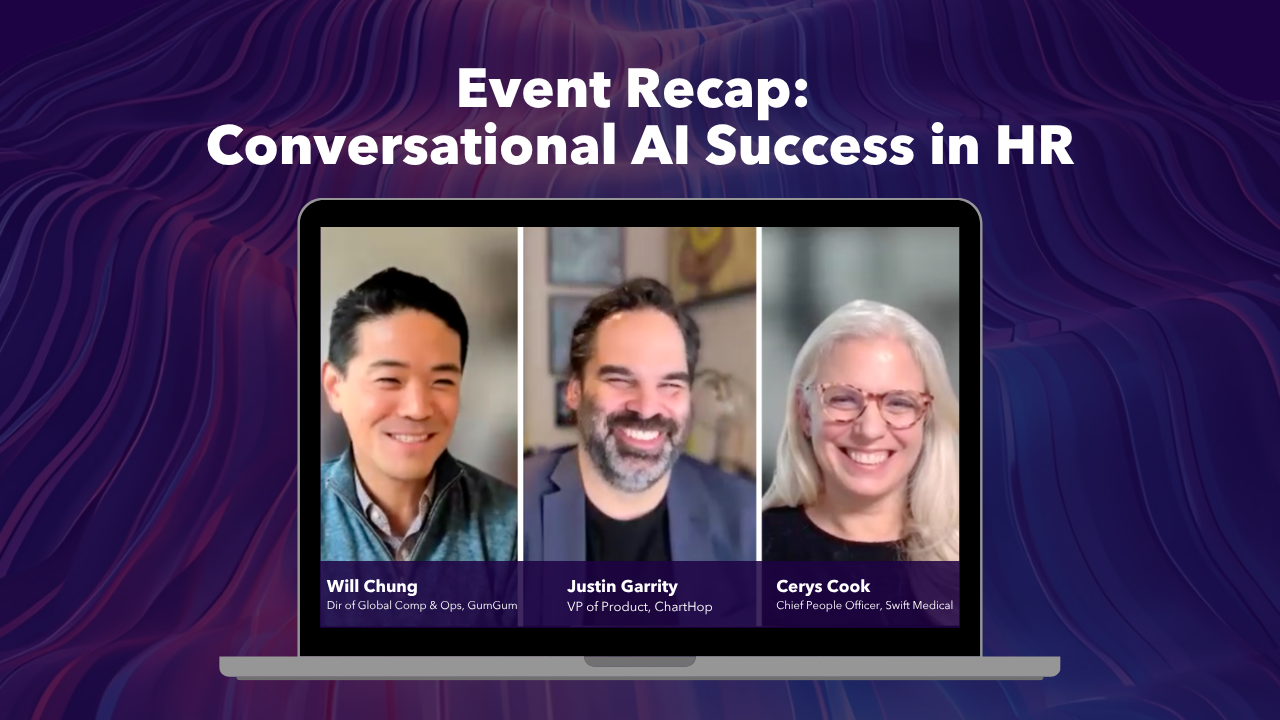

On November 13, 2025, ChartHop hosted a dynamic conversation, "How to Embed Conversational AI into Your Work," featuring two of our valued customers: Cerys Cook, Chief People & Transformation Officer at Swift Medical , and Will Chung, Director, Global Compensation & Operations at GumGum.
The discussion, moderated by ChartHop’s Head of Product, Justin Garrity , explored the real-world application of conversational AI in HR—from overcoming the fear of the "blank screen" to leveraging AI for strategic talent management and organizational change.
Here are the key takeaways and insights shared by our guests on their journeys with AI adoption.
Cerys Cook shared a truly unconventional and inspirational path into HR. She began her career as a chef , describing the professional kitchen 30 years ago as a "really, really tough environment" marked by long hours, volatile conditions, and rampant sexism.
Feeling frustrated and realizing that "workplaces shouldn't and didn't have to feel like that" , Cerys eventually transitioned to an office manager role where she "naturally started doing the people stuff". This evolved into a dedicated HR career, which she describes as the first time she felt like she was "meant to be" at work.
Cerys’s approach to AI adoption has been one of early enthusiasm followed by a thoughtful, disciplined reset. She was an early adopter, playing with ChatGPT the week it came out because it "felt like magic".
However, she realized she had gone "too far" when she found herself "sitting in front of a blank screen just going, 'I don't even know where to start without using AI'". This moment spurred a critical change in her workflow: She resolved never to "outsource my thinking or my voice".
Will Chung’s career began in a junior sales role, but he pivoted into HR after a recruiter introduced him to a job in Talent Acquisition (TA). After years in recruiting, he found his passion in Compensation , a field he loves for its depth (executive comp, equity, incentives) and its broad, company-wide impact.
GumGum, an advertising technology company , embraced AI early, quickly securing enterprise licenses to encourage widespread adoption while protecting data. Will’s personal journey began with playful experimentation (using AI as his own travel agent for a trip to Tulum) and evolved into using it as a tool for accelerated learning.
A highlight of Will’s AI journey was using it to revolutionize his hiring process for an analyst role. He was nervous that candidates would simply be "loading this into an AI tool, having it spell it exactly, be 100% right".
To combat this, he did something ingenious: He used AI to assess how he wanted to assess the candidates, effectively "AI-proofing" the screening process.
The AI suggested creating "questions and prompts that don't always have a right answer". This forces candidates to make judgment calls, allowing Will to "engage with, like, how someone's thinking about something, and not just, like, 1 plus 1 equals 2".
After the hire, Will leveraged ChartHop AI to onboard and train the new analyst. Because the tool is a "closed environment" with protected people data , it can help the analyst learn GumGum's data set and ChartHop systems, showing them "where to click and different toggles". This frees up Will’s time to focus on strategic relationship-building.
Will also shared his experience building custom projects (Gemini’s "gems") to streamline data auditing , focusing on the "garbage in, garbage out" concept.
He uses "execution guarantees" written into the prompt to ensure a consistent, structured output. He specifies conditions like, “don't consider this query done until XYZ is met... until you produce a downloadable Excel file with three tabs that include X, Y, and Z on each tab". This is essential because the AI’s "confidence level in the tone is always so high" even when the answer is wrong.
Justin Garrity weighed in on how ChartHop addresses the tension between human judgment and machine output, and questions about inconsistent outcomes with any conversational AI tool. Justin highlighted that one of the most significant impacts of AI has been reducing the complexity of customization. ChartHop has always aimed to be the most customizable and configurable HR platform, but prior to AI, achieving this required many options across different parts of the interface, which could be "challenging or overwhelming".
The conversation closed with the philosophical future of HR and AI.
Cerys wrapped up with a profound thought-provoking question for the audience:
"In a world where like, we truly have agentic AI embedded in how we work, like, what might even an org chart look like that captures that organizational capacity?". "But you know, 50 years from now, that one box could represent a million agentic AI support".
This shifted the conversation to the role of the future HR leader, who will be "engineering those conditions for human potential and machine intelligence to coexist" through "human systems design in a really profound way".
Cerys and Will are successfully using ChartHop AI to transform their teams, from protecting sensitive data to building a more efficient and strategic HR function.
Would you like to speak with a ChartHop expert about incorporating secure, conversational AI into your organization’s people operations platform? Reach out here.